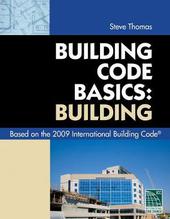
|
Code Basics Series: 2009 International Building Code
Paperback
Main Details
| Title |
Code Basics Series: 2009 International Building Code
|
| Authors and Contributors |
By (author) International Code Council
|
| Physical Properties |
| Format:Paperback | | Pages:208 | | Dimensions(mm): Height 269,Width 213 |
|
| Category/Genre | Building construction and materials |
|---|
| ISBN/Barcode |
9781435400672
|
| Classifications | Dewey:343.07869 |
|---|
| Audience | | Professional & Vocational | |
|---|
|
Publishing Details |
| Publisher |
Cengage Learning, Inc
|
| Imprint |
Delmar Cengage Learning
|
| Publication Date |
26 October 2009 |
| Publication Country |
United States
|
Description
For the first time, readers can gain a solid, working knowledge of critical building code applications without the text-heavy, complex, and sometimes abstract language that complicates many of the more traditional code related books that are available. BUILDING CODE BASICS: BUILDING, BASED ON THE 2009 INTERNATIONAL BUILDING CODE (R) is designed to tackle the basics of the IBC (R), including its essential requirements and intent, while maintaining an organized, user-friendly, and practical approach. It is one installment of Building Code Basics, a series dedicated to providing high-quality, technically accurate, simplified code books for readers who are unfamiliar with the underlying concepts of the I-Codes. Coverage follows the general purpose of the building code to provide fire, life, and health safety for the occupants of a building. Code references are also included, and when paired with non-technical explanations, they provide added value to the book's usefulness, making this an ideal tool for anyone in or entering the field of design, construction, or inspection of commercial buildings. Check out our app, DEWALT (R) Mobile Pro (TM). This free app is a construction calculator with integrated reference materials and access to hundreds of additional calculations as add-ons. To learn more, visit dewalt.com/mobilepro.
Author Biography
ICC is a leading organization dedicated to developing a single set of comprehensive, coordinated national model construction codes. To date, 48 U.S. states have adopted various international codes from ICC.
ReviewsPart I: CODE ADMINISTRATION AND ENFORCEMENT. 1. Introduction to Building Codes. History of Codes. Code Development. Building Codes: Scope and Limitations. Existing Buildings. 2. Legal Aspects, Permits and Inspections. Code adoption. Authority. Permits. Inspections. Board of Appeals. Definitions. Part II: BUILDING PLANNING. 3. Building Use. Inherent hazards in buildings. Basic Occupancies. 4. Construction Types. Combustible vs. Noncombustible. Protected vs. Unprotected. 5. Building Size. Maximum Height. Maximum Areas. Interior Dimensions. 6. Special Uses and Considerations. Multi-Use Buildings. Special Building Types. Vehicles in Buildings. Hazardous Materials. Part III: FIRE SAFETY. 7. Why Fire & Smoke Protection. Spread of Fire. 8. Passive Fire Protection. Determination of Fire Rated Construction. Types of Fire Separations. Interior Finishes. Stopping Air & Fire Movement. 9. Active Fire Protection. Fire Sprinklers. Standpipes. Fire Alarms. Controlling Smoke. Part IV: LIFE SAFETY. 10. Getting People Out. Design of Exit Systems. Components. 11. Getting People In. Federal Regulations. Accessibility. Rescue for People with a Disability. 12. Building Safety. Protection from Falls. Safety Glazing. Swimming Pools. Part V: HEALTH SAFETY. 13. Weather Protection Exterior Walls. Roofing. 14. Interior Environment Light & Ventilation. Temperature. Moisture Control. Plumbing Facilities. Part VI: STRUCTURAL SAFETY. 15. Structural Design. Basic Loads. 16. Materials. Structural. Non-structural.
|